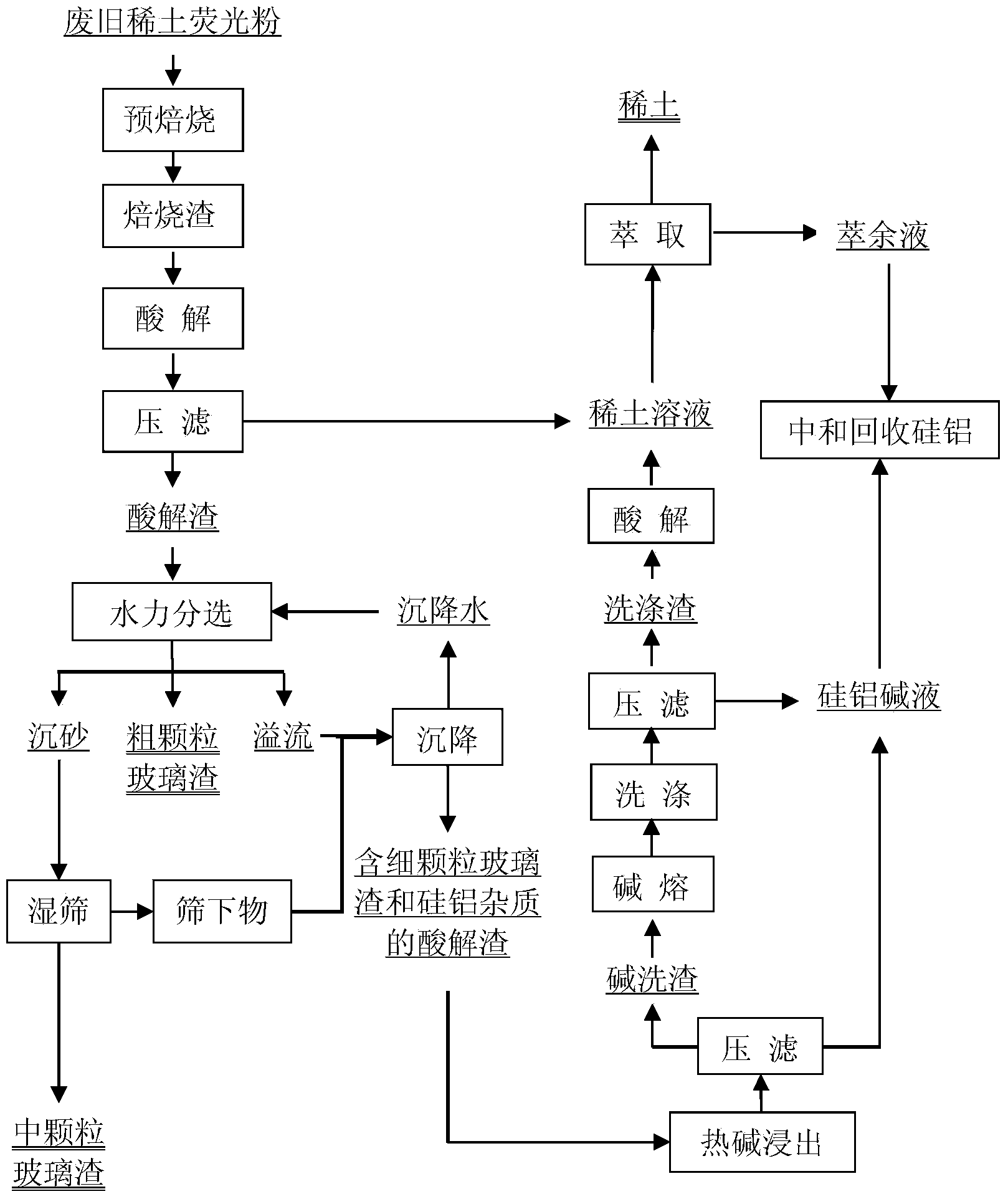Method for removing glass residue and silicon aluminum oxide in waste rare earth phosphor
A rare-earth phosphor and silicon-aluminum oxide technology, which is applied in chemical instruments and methods, luminescent materials, recycling technology, etc., can solve the lack of literature on the removal of silicon-aluminum impurity elements, reduce the leaching rate of rare earth elements, and extract rare earth elements. Low efficiency and other problems, to achieve the effect of improving the recovery rate of rare earths, reducing the amount of materials used, and no secondary pollution
- Summary
- Abstract
- Description
- Claims
- Application Information
AI Technical Summary
Problems solved by technology
Method used
Image
Examples
Embodiment 1
[0027] The collected waste rare earth phosphors were pre-calcined and roasted at 300°C for 3 hours. The roasted slag was subjected to acid acid hydrolysis to obtain rare earth solution and acid hydrolysis residue. The acid hydrolysis residue was sorted by hydrocyclone, wet sieving and sedimentation combined process , hydrocyclone sorting to remove coarse glass slag, sand settling through wet sieve for re-sorting to remove medium particle glass slag, the wet sieve mesh is 400 mesh, and the undersize after overflow and wet sieving is obtained by sedimentation and filtration The acid hydrolysis slag containing fine glass slag and silicon-aluminum impurities, and the settled water are returned to the hydrocyclone separation process. For acid hydrolysis slag containing fine particle glass slag and silicon-aluminum impurities, use 30 wt % NaOH solution, leaching residual fine particles of glass slag and silicon oxide, the solid-to-liquid ratio is 1:4, the leaching temperature is 90°...
Embodiment 2
[0030] The collected waste rare earth phosphors were pre-calcined and roasted at 400°C for 3.5 hours. The roasted residue was subjected to acid acid hydrolysis to obtain rare earth solution and acid hydrolysis residue. The acid hydrolysis residue was separated by shaking table, wet sieving and sedimentation. The hydrocyclone sorts to remove the coarse glass slag, and the sand settling is re-sorted through the wet sieve to remove the medium-sized glass slag. The mesh of the wet sieve is 300 mesh. Fine particle glass slag and acid hydrolysis slag of silicon-aluminum impurities, and settled water are returned to the hydrocyclone sorting process. For acid hydrolysis slag containing fine particle glass slag and silicon-aluminum impurities, use 30 wt % KOH solution, leaching residual fine particles of glass slag and silicon oxide, the solid-liquid ratio is 1:5, the leaching temperature is 100°C, and the leaching time is 1.5h. Alkali washing slag can remove glass slag and silicon-al...
Embodiment 3
[0033]The collected waste rare earth phosphors are pre-roasted and roasted at 500°C for 4 hours. The roasted residue is subjected to acid acid hydrolysis to obtain rare earth solution and acid hydrolysis residue. The hydrocyclone sorts to remove the coarse glass slag, and the sand settling is re-sorted through the wet sieve to remove the medium-sized glass slag. The mesh of the wet sieve is 300 mesh. Fine particle glass slag and acid hydrolysis slag of silicon-aluminum impurities, and settled water are returned to the hydrocyclone sorting process. Acid hydrolysis slag containing fine particle glass slag and silicon-aluminum impurities, using 50 wt % NaOH solution and KOH solution mixture, leaching residual fine glass slag and silicon oxide, the solid-liquid ratio is 1:6, the leaching temperature is 60°C, and the leaching time is 2h. Alkali washing slag can remove glass slag and silicon-aluminum oxide impurities in waste rare earth phosphors through alkali fusion and water was...
PUM
 Login to View More
Login to View More Abstract
Description
Claims
Application Information
 Login to View More
Login to View More - R&D
- Intellectual Property
- Life Sciences
- Materials
- Tech Scout
- Unparalleled Data Quality
- Higher Quality Content
- 60% Fewer Hallucinations
Browse by: Latest US Patents, China's latest patents, Technical Efficacy Thesaurus, Application Domain, Technology Topic, Popular Technical Reports.
© 2025 PatSnap. All rights reserved.Legal|Privacy policy|Modern Slavery Act Transparency Statement|Sitemap|About US| Contact US: help@patsnap.com

